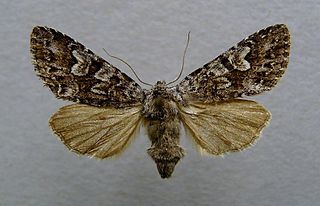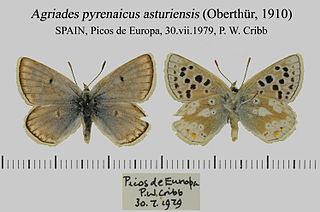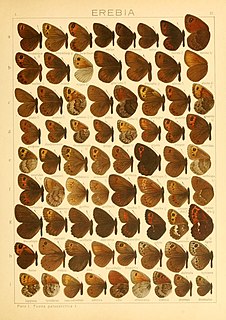
The Palearctic or Palaearctic is the largest of the eight biogeographic realms of the Earth. It stretches across all of Eurasia north of the foothills of the Himalayas, and North Africa.

Parnassius acdestis is a high-altitude butterfly found in India. It is a member of the genus Parnassius of the swallowtail family, Papilionidae. The species was first described by Grigory Grum-Grshimailo in 1891.

Parnassius actius, also known as the scarce red apollo, is a high-altitude butterfly found in Central Asia. It is a member of the snow Apollo genus (Parnassius) of the swallowtail family (Papilionidae).

Friedrich Joseph Adalbert Seitz, was a German physician and entomologist who specialised in Lepidoptera. He was a director of the Frankfurt zoo from 1893 to 1908 and is best known for editing the multivolume reference on the butterflies and larger moths of the world Die Gross-Schmetterlinge der Erde which continued after his death.

Parnassius eversmanni, or Eversmann's parnassian, is a high-altitude butterfly which is found in eastern Russia, Mongolia, Japan, Alaska, and the Yukon. It is a member of the snow Apollo genus (Parnassius) of the swallowtail family, Papilionidae. The species was named to honour Eduard Friedrich Eversmann.

Parnassius nordmanni is a high altitude butterfly which is found the Caucasus. It is a member of the snow Apollo genus (Parnassius) of the swallowtail family, Papilionidae. The larva feeds on Corydalis species including C. alpestris, C. conorhiza and C. emanueli.

Scolitantides orion, the chequered blue, is a species of butterfly in the family Lycaenidae. It is found in Europe, Russia and east across the Palearctic to Japan.

Amblopala is a Palearctic and Indomalayan butterfly genus in the family Lycaenidae. The genus is monotypic containing the single species Amblopala avidiena the Chinese hairstreak. It is a small butterfly found in the Naga Hills of India and in China

Polyommatus daphnis, the Meleager's blue, is a butterfly of the family Lycaenidae.

Pararge xiphioides, the Canary speckled wood, is a butterfly of the family Nymphalidae. It is found in the Canary Islands on La Gomera, La Palma, Tenerife and Gran Canaria.

Sedina buettneri, or Blair's wainscot, is a moth of the family Noctuidae. The species was first described by Eduard von Hering in 1858. It is found in the Palearctic realm. Outside of Europe, it is occasionally found in temperate Asia, the coast of the Black Sea, the base of the Caucasus mountains, the Caspian Sea, Iran, Russia east to the Urals, Lake Baikal and Altai regions, and in Japan and the Kuril Islands.

Papestra biren, the glaucous shears, is a moth of the family Noctuidae. The species was first described by Johann August Ephraim Goeze in 1781. It is found in most of Europe, but not in the southern parts of the Iberian Peninsula, Italy and Greece. Outside of Europe it is found in Kashmir and through the Palearctic to Siberia, Central Asia, Amur, Kamchatka, the Russian Far East and Japan. It was introduced in Newfoundland in 1935 and has since then extended its range ever more southward within North America partly overlapping with Papestra quadrata(Smith, 1891). It rises to 2200 m above sea level in the Alps.

Agriades pyrenaicus, the Gavarnie blue, is a Palearctic butterfly of the family Lycaenidae. It is found in the Asturias mountains of north-western Spain, the Pyrenees, the southern Balkan Peninsula, Turkey, the Caucasus and Armenia. The habitat consists of alpine grassy rocky meadows where it is found at altitudes ranging from 1,500 to 2,200 meters.

Lysandra corydonius, the false chalkhill blue, is a butterfly of the family Lycaenidae. The species is distributed in south-eastern Europe, Caucasus, Transcaucasia, north-eastern Turkey, and north-western Iran. L.corydonius is very similar to Lysandra coridon but a slight violet sheen is present, especially in the outer area of the wings. .It inhabits a wide variety of grasslands and woodlands. In Armenia it occurs from 1200 to 2000 m above sea level. The known larval host plants of the species in Turkey is Hippocrepis comosa, in the Caucasus - Coronilla varia. The species has not been assessed for the IUCN Red List. In Armenia from 2003 to 2013 its population increased.

Lycaena candens is a small butterfly found in the Palearctic that belongs to the lycaenids or blues family.

Erebia iranica is a butterfly found in the East Palearctic that belongs to the browns family. E. iranica Gr.-Grsh. was described as a forma of Erebia tyndarus from North Persia. It is often smaller than the nymotypical form of tyndarus, the band of the fore- and hindwing being rather bright russet-red. The subapical ocelli of the forewing are large and bear bright white pupils.

Neolysandra coelestina is a butterfly found in the Palearctic that belongs to the blues family.

Polyommatus boisduvalii is a butterfly found in the Palearctic that belongs to the blues family.


















